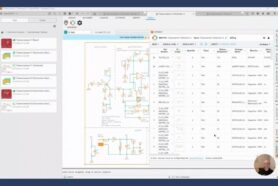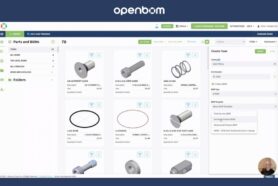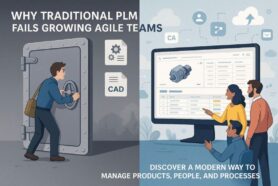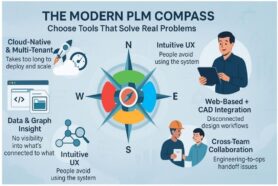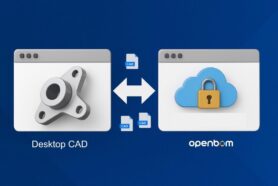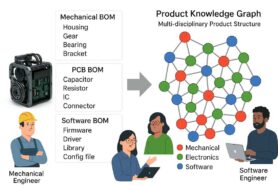
In the domain of design and product development, Computer-Aided Design (CAD) and Excel have long been coming together. CAD systems empower designers to create detailed, accurate models of products, while Excel spreadsheets are used extensively for managing various aspects of product data. One of the most typical ones is to export a part list including raw materials, for ordering purposes, supply chain management, or enterprise resource planning (ERP) system.
However, as product complexity and market competition intensify, relying solely on CAD exports to Excel for managing product data is increasingly insufficient. This is where engineering teams and manufacturing companies started to search for a better way to manage data and Product Lifecycle Management (PLM) systems come into play.
The Limitations of Excel in Managing Product Data:
Scalability Challenges: Excel and spreadsheets in general are well-suited for small-scale data management. You can export a list of 20-30 parts and should be fine. However, when dealing with large volumes of product data, it struggles. When you need to manage 500-1000 component assemblies with multiple levels and sub-assemblies, a spreadsheet will be a bad idea. It is like bringing a computer from the 1990s to the 21st century. Complex products can generate data that are too complex and intertwined for Excel’s flat document structure. Also, re-use is impossible with Excels. The same screw defined in two different Excel is not the same object. You end up with the wrong data.
Data Integrity Risks: Excel lacks robust version control, leading to challenges in maintaining data accuracy and consistency. Multiple versions of the same spreadsheet can lead to confusion and errors. Dependencies between spreadsheets combined with revision control is an impossible nightmare.
Collaboration Shortfalls: In today’s global and connected environment, teams are often distributed across different locations and organizations. Excel’s limited collaboration capabilities can hinder real-time data sharing and teamwork. The companies can spend a lot of time to sync data between systems using Excel.
Inadequate Integration: Excel is not inherently designed to integrate seamlessly with other enterprise systems such as ERP, SCM, or CRM. Although each system can export Excel, the data mapping and transformation is impossible. This lack of seamless integrations can create silos and inefficiencies.
Why PLM Systems are Crucial for Product Data Management
Here are 5 reasons why bringing a data management system such as PLM is important.
Centralized Data Repository: PLM systems provide a centralized platform for storing and managing all product-related data throughout its lifecycle. This centralized approach enhances data accessibility and integrity. Moreover, a multi-tenant PLM system can connect people and teams working in different companies together.
Enhanced Collaboration: PLM systems are built to facilitate collaboration. Team members can access and modify data in real-time, regardless of their geographical location, ensuring everyone is on the same page.
Advanced Version Control: PLM systems offer sophisticated version control features. This ensures that everyone is working with the most up-to-date and accurate product information, reducing errors and redundancies.
Seamless Integration with Other Systems: PLM systems are designed to integrate with other enterprise systems, creating a cohesive and efficient workflow across the entire organization.
Product Information traceability: PLM systems are capable to trace relationships between product information in different stages of lifecycle, connect siloed data.
How OpenBOM is Different?
PLM system development goes back 20-30 years. What is different today and why OpenBOM is uniquely positioned to replace Excel and spreadsheet reports:
- Flexible graph-based data model. It allows you to dynamically create all elements of data, which eliminates the need for traditional mapping and the complexity of data management. In fact, OpenBOM allows you to modify data models exactly like Excel does, but… data lives in the product knowledge graph.
- Seamlessly integrate with all CAD systems, spreadsheets, Google Sheets, and other data sources. This is a real killer because you can easily import any data to OpenBOM. Using one-click integrations with CAD systems helped to collect data automatically.
- The multi-tenant data model allows you to share data in real time between companies and teams without the need to export data to external data sources.
- Seamless user experience a-la Google Sheet in OpenBOM gives you a feeling of a spreadsheet while working with a structured system of objects and databases.

Customer Stories
Here is an example of OpenBOM customer Fly Pyka. Learn their story about how FlyPyka replaced Google Spreadsheets with OpenBOM to manage one source of truth for autonomous electric airplane development. Here is an interesting passage:
Pyka Lead Mechanical Engineer Garrett Rini described the product’s evolution “moving from prototyping to production manufacturing is really hard. We needed to button down parts, assemblies, and procedures and pass that information along to the manufacturing teams.”
“Our airplanes have lots of parts and assemblies to keep track of across two distinct teams, Engineering and Manufacturing, and we need to be on the same BOM all of the time. Getting all of that info straight was a big problem and Google sheets wasn’t going to get us there.” Says Garrett.
“We were basically trying to build OpenBOM in Google sheets,” he says. After a bit of research, OpenBOM for Teams was a perfect fit for this rapidly growing company. One thing that was attractive was the low barrier to taking us several steps further than Google sheets. We could import directly from Solidworks, an existing Google sheet, or just type in data. OpenBOM functions the way we would expect it too.” says Garrett.
Pyka relies on OpenBOM for Solidworks integration to reliably capture product structure and design intent. That means a reliable way to create BOMs of designs that contain the expected items AND a reliable way to update them as they evolve. While the primary design tool is Solidworks, Pyka has a bit of everything including PCBA and other tools. Two teams and eight engineers all creating data and BOM changes to eventually make a product.
Conclusion:
While Excel and CAD are valuable tools in their own right, they fall short in addressing the complexities of modern product data management. PLM systems fill this gap, offering a more robust, scalable, and integrated approach to managing the lifecycle of a product. As businesses continue to navigate an increasingly competitive and complex market, the adoption of PLM systems is not just advantageous but essential for sustainable growth and innovation.
Are you still relying on CAD exports and Excel for managing your product data? It’s time to explore the dynamic world of PLM systems. Transform your product data management today for a more efficient and competitive tomorrow.
REGISTER FOR FREE to start your OpenBOM trial and see first hand how it can help you today.
Best, Oleg
Join our newsletter to receive a weekly portion of news, articles, and tips about OpenBOM and our community.


